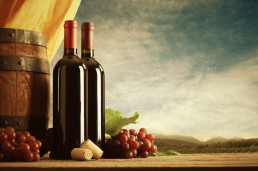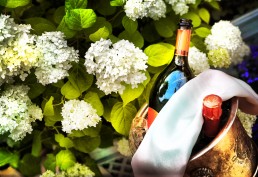Is Red More Grown-up?
Realistically, most people fall into two camps when it comes to wine – you’re either a red or white drinker. There’s the odd person who prefers rosé but in the main, it’s red or white.
Is there any reason for this binary choice and what does it mean for both camps? Red wine drinkers are often seen as more mature, well-travelled and educated and white wine drinkers can be seen as younger and not so clued-up yet. Could it be the way in which young adults are introduced to wine and other alcohol that influences their choices?
Starting off all-white
When young adults first try alcohol, they often start off on a light white wine or some fizz at a family occasion. White wines are often seen as “safer” when it comes to hangovers and this, as well as the fact that a first glass of fizz is drunk within the security of a family setting, forms an association.
People get to know their limits with white wines, usually, so any deviation from the familiar can make people feel nervous. There’s also been lots of marketing in recent years that shows young women having a riot with their friends over a bottle (or two) of Pinot Grigio. If you drink white, you’re young, fun and adventurous…
So where does this leave the reds?
It’s instinctive to feel a bit apprehensive about red wines and many people don’t try them until their late 20s and even their 30s. It’s dark, you can’t see through it; plus, doesn’t it cause banging hangovers?
Some reds are more challenging than many whites – you get tannins, oaky flavours, they can be more bitter. They are more associated with older people who have had to acquire a taste for red.
Does this mean they’re more mature, though? Not necessarily. Reds are associated with maturity and life experience, but only in parts of the world where alcohol consumption follows the pattern outlined above. It’s not unusual, in Europe, to see younger people enjoying a glass of local tinto. If you’re stuck in a white wine rut, then bust out and try some lighter reds. You won’t instantly grow up, but you’ll be expanding your palate!
Does Wine Make You More Attractive?
Everyone knows that buying the right deodorant-furniture polish-canned dog food makes you bigger, stronger, hotter, better-looking and attracts the opposite sex like politicians to a lobbyist passing out thousand-dollar bills.
Now you can add wine to that list too.
Sort of, anyway. At least according to a study done by Bristol University’s School of Experimental Psychology and entitled “Increased Facial Awareness Following Moderate but not High Alcohol Consumption” (long-winded, those Brits). In the study, volunteers were shown more than 100 photographs of subjects who had consumed a single glass of wine, more than one glass and no wine at all. The single-glass drinkers were rated as more attractive than those were either stone-cold sober or had downed more than one glass.
That conclusion, a University press release states, was “presumably driven by changes in appearance. The researchers suggest that vasodilation associated with alcohol consumption could lead to an increase in facial flushing, which is perceived as healthy and attractive. Low doses of alcohol may also result in an increase in positive mood that is apparent in subtle smiles and more muscle relaxation.”
Hey, we always knew a glass (or two or three) of wine is a great way to chill out. Now go out and buy the right deodorant-furniture polish-canned dog food and you’ll be damn near irresistible.
Grocery Stores Are the New Wine Shops
If it seems like your local supermarket is putting as much effort into selling wine as peddling tomatoes, toilet paper and laundry detergent, well, you’re right. And they may be cutting into the business of stand-alone wine merchants.
How big is wine for supermarkets?
Plenty big. In terms of dollars, it was the seventh biggest seller of every item in the market in 2014, ahead of coffee, cereal and even—gasp!—bacon. (In fact, last year supermarket wine sales rose by 3.7 percent, while sales of toilet paper dropped 0.2 percent. Ponder that next time you’re on the porcelain throne.)
Some 42 percent of all the wine sold in the U.S. last year was sold in supermarkets, which comes to almost $9 billion. And that’s despite the fact that wine is subject to all manner of sales restrictions in many states and can’t be sold at all in grocery stores in 15 states, including such major players as New York and Pennsylvania.
It’s not just the cheapest plonk we’re buying. The average bottle price of wine purchased in supermarkets is $9, not exactly Petrus territory but not Boone’s Farm either.
With those kinds of dollars at stake, supermarkets aren’t letting any arugula grow under their feet. With the support of grocers’ groups, legislators in many of the 15 prohibitionist states have introduced bills to allow wine sales; Tennessee recently passed such a law and the first applications have already been approved.
In states where grocery store wine sales are legal, stores are ramping up both their presentation and informational capabilities. Some have created in-store “wine shops,” mimicking the look of small specialty wine merchants, while others—like the giant Raley’s chain in California, have added “wine specialists” to their staffs to help consumers choose from among the thousands of bottles on display. Don’t worry, though. You can still pick up a box of cereal and a roll of toilet paper. . .
Device Pours Wine Without Opening Bottle
If walking on water is just too hard, you can still amaze your friends and confound your enemies by pouring a bottle of wine without ever removing the cork.
Better still, it takes no God-like or supernatural powers. All it takes is a Coravin, a new piece of “wine access technology” from a Boston inventor-slash-entrepreneur-slash-wine geek who was looking for a way drink a glass of his favorite vino without having to finish off (or pour out) the entire bottle.
Resembling something of a cross between a microscope and a hypodermic syringe for the Jolly Green Giant, the Coravin works by pushing a thin, hollow needle through a wine cork, then injecting argon gas into the bottle, which displaces the wine and allows the user to pour it in a glass through a spout.
The trick, if you can call it that, is that the hole in the needle is in the side, not the tip, so when it’s inserted in a cork and removed it leaves no opening; the elastic cork simply closes back up again. With the cork intact and the empty space in the bottle filled with argon gas, no oxygen can get in to degrade the wine.
Wine writers as respected as Jancis Robinson have vouched for the Coravin, and groups of sommeliers in San Francisco and New York were reportedly unable to taste any difference in wines that had been sampled via a Coravin, left for nine months, then sampled again.
Now, the Coravin is not exactly cheap, costing $299 on Amazon. But great wine isn’t cheap either. And the chance to drink it a glass at a time without the wine ever going bad?
Are More Expensive Wines Actually Better?
This is a real apples v oranges, chicken v egg question. Is a $30 bottle of wine any better than a $5.00 bottle? It’s just grape juice that’s been fermented, right? So what’s the difference? Is there a difference?
Quite simply, yes. It’s maybe not so much about the price, though, but about how well-made and prepared the wine is and when you try one that’s good quality, you’ll know.
There are actually measurable differences between mass-produced, cheap wine and wine from a micro-vineyard where the grapes are serenaded every night (this doesn’t really happen). The differences come from the growing methods and the winemaking methods involved. Even if you’re not a big wine fan, you should understand that scales of economy, production techniques and time can affect the price of wine – or indeed, any product,
The quality of the vineyard matters
The best soils and climates are limited, so people will pay a premium for vintages from these places. This is the terroir – the total environment that the grapes are grown in – the soil, the amount of sunlight and the wind direction all have an effect.
If a vineyard is in a great spot, you’ll get great grapes, which, given expert treatment, results in great wines. This comes at a premium, as these places aren’t necessarily the easiest places to farm on.
Then there’s the winemaking process itself
The techniques used, the equipment, the barrels, the aging process, the small children who have to be bribed to squash the grapes… It all has its part to play too. This process is handled by experts, each of whom has his or her own twists and touches. This expertise costs money – quite rightly too, because you’re paying for years, maybe generations, of experience.
These guys have to produce wines with the right balance between acid, alcohol, tannin and sugar, regardless of the grape. This takes skill and the application of subtly different fermentation techniques to achieve this balance and maintain the taste of the terroir. You try that at home, kids!
Then there’s the barrels
Storing and aging wine costs money. These barrels aren’t shoved into the basement and forgotten about – aging is a dynamic process that requires monitoring and judgement.
Of course you could say that it’s all subjective, and if you like your $5.00 plonk more than the $30.00 vintage, then fill your boots! You can’t, however, say that the cheapie is as good.
Image Credits
Copyright for the image within this blog post is owned by ‘Uliannaholbox’, and has been licenced for use on this blog post through Big Stock Photo (stock photo ID: 156826238). For questions relating to this image please contact the copyright owner directly.
Will El Nino Bust California’s Drought?
California winemakers have so far escaped any serious consequences from the state’s unprecedented drought. That luck, however, cannot hold forever, and if meteorologists and other climate experts are right, it won’t have to.
It’s becoming increasingly likely that relief, albeit mostly temporary, will come this winter in the form of El Nino, the climatological phenomenon marked by an increase in the sea surface temperature of the Pacific Ocean, typically resulting in higher rainfall totals in California and the western United States.
Over the past several months, scientists at the National Oceanic and Atmospheric Administration have steadily increased the odds to a virtual certainty of California being on the receiving end of much-needed rainfall due to a strong to very strong El Nino. A possible sign of things to come occurred in the area around Truckee and Lake Tahoe in July, when rare summer rain and hailstorms surprised and gratified tourists and locals alike. (Okay, so locals were a lot more gratified than tourists.)
Still, even a deluge of Biblical proportions this winter won’t get the state out of its years-long drought. It will, however, lessen some of the pressure on California’s groundwater reserves, which many vintners and farmers have been tapping into to irrigate their crops. Though grapevines are hardy little suckers that can withstand prolonged dry spells, many vintners are concerned that drought-affected vines will produce lower yields, even if in some cases quality might be improved.
Another worry is the accumulation of salt in soils after so many dry years. Wet weather washes that excess salt away, but without regular cleansings too-salty soils can cause grapevines to lose their leaves, resulting in grapes that can’t fully ripen. That’s the long version. The short version: Pray for rain.


